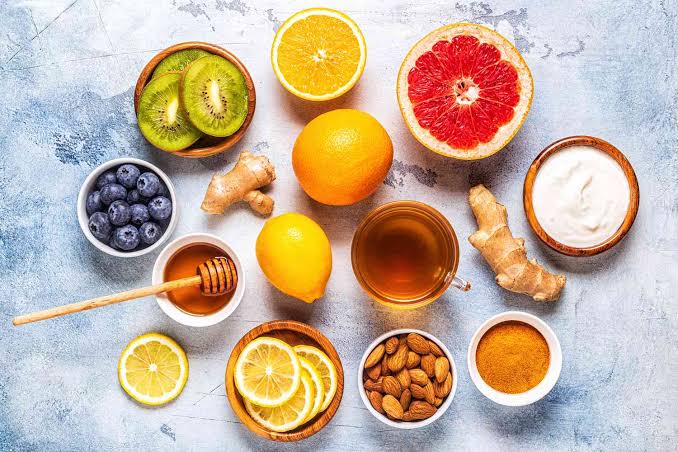
Introducing Solid Foods for Healthy Growth
Introducing solid foods is a vital milestone for babies, supporting their physical growth, brain development, and healthy eating habits. Around 6 months, babies are ready to explore simple purees, cereals, fruits, and vegetables. Parents should introduce foods gradually, watch for allergies, and continue breastfeeding or formula feeding alongside.
💪 Fitness Guru
40 min read · 21, Aug 2025

Introduction
A baby’s growth journey is one of the most exciting experiences for parents. From the first smile to the first crawl, every milestone matters. One of the biggest steps in this journey is introducing solid foods. Transitioning from breast milk or formula to solids is more than just a dietary change—it’s the beginning of a new phase of growth, development, and exploration for your child.
Solid foods provide essential nutrients that breast milk or formula alone cannot fully cover after a certain age. They also expose babies to different tastes and textures, shaping their food preferences for life. But the process requires patience, awareness, and mindful choices to ensure healthy growth and long-term well-being.
In this article, we’ll explore the right time to introduce solids, the best first foods, common mistakes to avoid, daily and weekly routines, and practical tips for raising a happy, healthy eater. The journey of a baby’s growth is filled with countless milestones, and one of the most important among them is the introduction of solid foods. This stage is not only exciting for parents but also critical for the healthy development of the child. For the first six months of life, breast milk or formula provides all the essential nutrients a baby needs. However, as babies grow, their nutritional requirements expand, and the gradual introduction of solid foods helps bridge this gap. The way solids are introduced can shape a child’s eating habits, nutritional intake, and overall health in the long run.
When a baby reaches around six months of age, their body is usually ready to handle more than just milk. Their digestive system matures enough to process simple foods, their tongue-thrust reflex diminishes, and they develop the ability to sit with minimal support, all of which are signals that it is the right time to start. Parents often look forward to this moment with excitement, imagining their baby tasting new flavors for the very first time. However, it is important to remember that introducing solid foods is not a replacement for milk at this stage but a supplement. Breast milk or formula still remains the primary source of nutrition until the first year, with solids gradually playing a larger role.
The process of introducing solids should be slow, gentle, and patient. Babies are naturally curious but also sensitive to change, so offering one new food at a time allows them to adjust. Single-ingredient purees like mashed banana, cooked carrots, or soft rice are common first foods. These are easy to digest and low in allergens, making them a safe starting point. Once the baby accepts these, more variety can be added, such as apples, peas, or pumpkin. Offering iron-rich foods early is also crucial since by six months, a baby’s natural iron stores start depleting. Foods like pureed lentils, iron-fortified cereals, or mashed beans help in maintaining healthy growth and preventing deficiencies.
Texture progression is another important aspect of introducing solids. Initially, purees are best, as they are soft and easy to swallow. Gradually, as the baby learns to move food around the mouth and develops stronger chewing skills, mashed and then small soft finger foods can be offered. This transition not only aids physical development but also exposes the child to a wide range of textures, which can prevent picky eating in the future. Allowing babies to touch and explore their food builds sensory awareness and encourages independence. Some parents also adopt the baby-led weaning approach, where instead of spoon-feeding purees, babies are offered soft finger-sized pieces of food to self-feed from the beginning. While both methods have their benefits, the key is ensuring safety and making sure foods are appropriately soft and small enough to avoid choking hazards.
The introduction of solid foods is also the time to expose children to a variety of flavors. Early exposure to different tastes can reduce fussiness later in life. Vegetables, fruits, whole grains, and protein sources should be rotated to provide balanced nutrition. Parents are often tempted to offer sweet foods first, but it is better to begin with vegetables since babies naturally lean towards sweetness. Developing a taste for greens and mildly bitter foods early can help establish healthier eating habits as the child grows.
Safety and health must remain the top priority during this stage. Certain foods such as honey, whole nuts, and unpasteurized dairy should be strictly avoided in the first year due to the risks of allergies, choking, and infections. Salt and sugar should also be minimized, as babies’ kidneys are not fully developed to handle excess sodium, and sugar can set unhealthy preferences for sweet foods. Instead, natural flavors from fruits and mild spices can be used to gently enhance the taste of food. Parents should also keep a close watch for allergic reactions when introducing new foods. Offering one new food at a time and waiting three to five days before introducing another helps identify any sensitivities or allergies such as rashes, diarrhea, or breathing difficulties.
The introduction of solids is more than just nutrition; it is also about building a relationship with food. Mealtime should be seen as an opportunity for bonding and exploration rather than just feeding. Allowing the baby to join family meals, even if they are only nibbling on small pieces, helps them learn through observation. Creating a positive, stress-free eating environment encourages healthy associations with food. Babies may sometimes spit out food or refuse to eat, but patience is vital. Pressuring or forcing can lead to negative food relationships, whereas consistent gentle encouragement builds trust and willingness to try.
Cultural traditions often play a role in deciding which foods are introduced first. Some families start with rice porridge, others with lentils, or some with mashed fruits. While these variations are natural and meaningful, the foundation of healthy growth lies in ensuring balance, variety, and nutritional adequacy. Modern research also emphasizes the importance of introducing allergenic foods like peanuts, eggs, or fish in small, controlled amounts after six months, as this can actually reduce the chances of developing long-term allergies, provided there is no family history of severe allergies.
As babies move towards their first birthday, solids begin to take a more central role in their diet. By the end of the first year, most children are eating from all food groups in small portions alongside breast milk or formula. This transition sets the stage for the toddler years, where growth and activity levels increase, demanding an even more diverse and nutrient-dense diet. Parents who pay attention to variety, safety, and positive food experiences during this critical stage give their child a strong foundation for lifelong healthy eating.
Introducing solid foods is a gradual, joyful, and sometimes challenging process, but it is one of the most rewarding parts of parenthood. It marks a child’s first steps towards independence, discovery, and growth. With patience, care, and mindful choices, parents can ensure that this stage not only supports healthy physical development but also nurtures a love for wholesome food that lasts a lifetime.
When to Start Solid Foods
Health experts, including the World Health Organization (WHO) and pediatricians, recommend introducing solid foods around 6 months of age. By this time, most babies:
- Can sit with minimal support
- Have good head and neck control
- Show interest in food by watching others eat
- Open their mouth when food approaches
- Have lost the tongue-thrust reflex (pushing food out automatically)
Starting solids too early (before 4 months) can increase allergy risk, while delaying beyond 8 months may affect growth and acceptance of textures.
Why Solid Foods are Important for Growth
- Fills Nutritional Gaps
- After 6 months, breast milk or formula alone may not provide enough iron, zinc, and certain vitamins. Solids bridge this gap.
- Supports Brain Development
- Nutrients like iron, omega-3 fatty acids, and B vitamins from solids play a crucial role in brain growth.
- Encourages Motor Skills
- Eating teaches coordination of tongue, lips, and swallowing, strengthening oral motor development.
- Shapes Food Habits
- Introducing a variety of flavors early reduces picky eating later in childhood.
- Boosts Immunity
- Fruits, vegetables, and grains provide antioxidants and minerals that strengthen the immune system.
Best First Foods for Babies
- Iron-Rich Foods
- Since babies’ iron stores start depleting after 6 months, iron-rich foods are essential.
- Mashed lentils, pureed beans, spinach puree, iron-fortified cereals
- Fruits
- Easy-to-digest and naturally sweet.
- Banana mash, apple puree, pear mash, papaya
- Vegetables
- Provide fiber, vitamins, and minerals.
- Carrot puree, sweet potato mash, pumpkin puree
- Grains
- Introduce single-grain foods first.
- Rice porridge, oatmeal, ragi (finger millet) porridge
- Proteins (after 7–8 months)
- Mashed boiled egg yolk, paneer, tofu, fish (boneless, well-cooked)
- Healthy Fats
- Small amounts of ghee, avocado mash, or olive oil
How to Introduce Solids Step-by-Step
- Start Slow
- Begin with 1–2 teaspoons once a day, gradually increasing portion size.
- Single-Ingredient Foods First
- Offer one new food at a time and wait 3 days before introducing another. This helps identify allergies or intolerances.
- Smooth Texture Initially
- Start with purees or well-mashed foods, then move to soft lumps and finger foods over time.
- Encourage Self-Feeding
- Once your baby shows interest, allow them to touch food, explore, and try finger foods.
- Stay Patient
- It may take 8–10 tries before a baby accepts a new food. Don’t give up quickly.
Foods to Avoid in the First Year
- Honey (risk of infant botulism)
- Cow’s milk as a main drink (can be introduced after 1 year)
- Whole nuts (choking hazard)
- Added sugar, salt, or processed foods
- Undercooked eggs, meat, or fish
Daily Solid Food Routine for Babies (6–12 Months)
Morning
- Continue breastfeeding or formula feeding
- Offer a small portion of mashed fruit (banana, papaya)
Midday
- Vegetable puree (carrot, pumpkin) or lentil mash
- A few spoonfuls of iron-fortified cereal
Evening
- Grain porridge (rice, ragi, oats) with a drizzle of ghee
- Small fruit portion if baby is still hungry
Night
- Breastfeed or formula feed before sleep
Gradually, by 9–12 months, babies can eat 3 small solid meals and 1–2 snacks along with breast milk or formula.
Weekly Practices for Smooth Transition
- Introduce 1–2 new foods per week
- Slowly increase texture variety: puree → mash → soft lumps → finger foods
- Encourage baby-led weaning with soft finger foods like boiled carrots, steamed apple slices, or soft roti pieces
- Create a positive mealtime environment—no screens, no rushing
- Keep a baby food journal to track likes, dislikes, and reactions
Signs of Food Allergies to Watch For
When introducing new foods, keep an eye out for:
- Rash or hives
- Vomiting or diarrhea
- Swelling of lips, eyes, or face
- Difficulty breathing
If you notice these symptoms, stop the food and consult a pediatrician immediately.
Common Mistakes Parents Make
- Forcing the Baby to Eat
- Babies eat according to hunger cues. Forcing creates aversion to food.
- Adding Sugar or Salt
- Babies’ kidneys can’t handle extra salt, and sugar leads to unhealthy preferences.
- Introducing Too Many Foods at Once
- This makes it difficult to identify allergies and overwhelms the baby.
- Expecting Clean Eating
- Babies learn by playing with food. Mess is part of the process.
- Comparing Eating Habits with Other Babies
- Every child’s appetite and pace are unique.
Myths About Introducing Solids: Busted!
“Rice water is enough as a first food.”
→ False. Rice water has minimal nutrition. Babies need iron-rich foods and variety.
“Starting solids early makes babies sleep better.”
→ Not true. Solids don’t guarantee longer sleep and may upset digestion if introduced too soon.
“Fruit juices are good for babies.”
→ Wrong. Whole fruits are better. Juices lack fiber and may damage teeth.
“If baby refuses food once, they’ll never like it.”
→ Not true. It often takes several tries before acceptance.
“Solids should completely replace milk at 6 months.”
→ Incorrect. Breast milk or formula remains the main source of nutrition until 1 year.
Sample First Week Solid Food Introduction Plan
Day 1–2: Mashed banana (2 tsp, once daily)
Day 3–4: Carrot puree (2–3 tsp, once daily)
Day 5–6: Rice porridge with a drop of ghee
Day 7: Apple puree
From the next week, slowly add lentils, oatmeal, pumpkin, or spinach puree.
Conclusion
Introducing solids is not just about feeding—it’s about nurturing healthy growth, exploring tastes, and building a foundation for lifelong eating habits. With patience, variety, and consistency, your baby will learn to enjoy food while gaining essential nutrients for brain, body, and immune development.
Start slow, respect your baby’s hunger cues, and make mealtimes positive. Whether it’s the first spoon of mashed banana or a playful attempt at finger foods, every small step contributes to healthy growth and joyful discovery.
Remember: Solids complement—not replace—breast milk or formula in the first year. With love and mindful choices, you’ll raise a confident little eater, ready for a lifetime of healthy habits.
Q&A Section
Q1:- What does introducing solid foods mean for a baby’s growth?
Ans :- Introducing solids is the gradual process of moving a baby from a milk-only diet to nutrient-rich foods. It supports healthy growth, stronger immunity, and developmental milestones.
Q2:- When is the right age to start solid foods?
Ans :- Most pediatricians recommend starting solids at around 6 months, when the baby can sit with support, shows interest in food, and has good head control.
Q3:- What are the first solid foods usually given to babies?
Ans :- Iron-fortified single-grain cereals, pureed fruits, vegetables, and mashed lentils are common starter foods. They are easy to digest and packed with nutrients.
Q4:- Why is iron-rich food important at this stage?
Ans :- Babies’ iron stores from birth begin to deplete around 6 months. Iron-rich foods like fortified cereals, spinach, and lentils help prevent anemia and support brain development.
Q5:- How should new foods be introduced to avoid allergies?
Ans :- Introduce one new food at a time and wait 3–5 days before adding another. This makes it easier to spot any allergic reactions.
Q6:- What foods should be avoided during the first year?
Ans :- Honey, whole nuts, excess salt, sugar, and cow’s milk should be avoided, as they may cause allergies, choking hazards, or digestive issues.
Q7:- How do textures progress as the baby grows?
Ans :- Start with purees, then move to mashed and finely chopped foods by 8–10 months. By 12 months, babies can enjoy small soft finger foods.
Q8:- Why is responsive feeding important during this stage?
Ans :- Paying attention to the baby’s hunger and fullness cues helps develop healthy eating habits, prevents overfeeding, and builds trust between parent and child.
Q9:- Can solid foods replace breast milk or formula immediately?
Ans :- No, breast milk or formula should remain the primary source of nutrition for the first year. Solids complement milk but do not replace it entirely.
Q10:- How can parents encourage healthy eating habits early on?
Ans :- Offering a variety of colorful, nutrient-rich foods and being patient with the baby’s preferences builds a foundation for lifelong healthy eating patterns.
Similar Articles
Find more relatable content in similar Articles

Epigenetics and Exercise – How Your Workout Affects Your Chi..
“Exploring how regular physica.. Read More

Fitness for Gamers: Keeping Body Active During Long Gaming H..
“Balancing Mental Focus with P.. Read More

How to Build a Skincare Routine Based on Your Skin Type (Oil..
A personalized skincare routi.. Read More

Superfoods that naturally boost immunity..
Superfoods are nature’s immun.. Read More
© 2024 Copyrights by rFitness. All Rights Reserved.